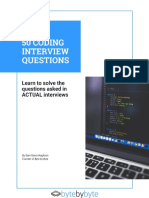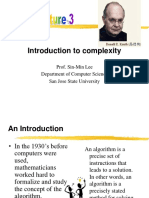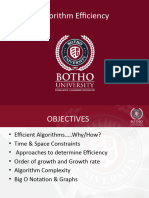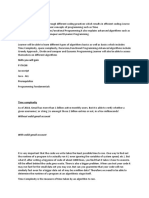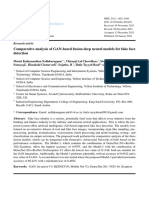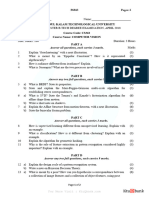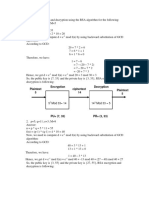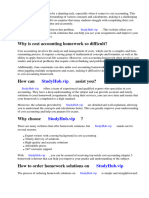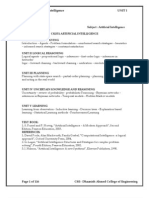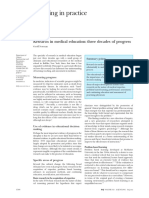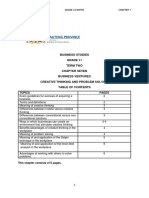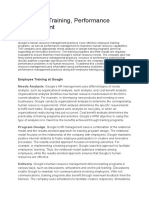DSA Intro To Problem Solving and Data Structures - Module 2
Uploaded by
Niharika DubeyDSA Intro To Problem Solving and Data Structures - Module 2
Uploaded by
Niharika DubeyDSA: Intro to Problem Solving and Data Structures
Module 2: In-Class Training - JNTU Manthani
Recently, I conducted a comprehensive Introductory DSA training sessionat JNTU Manthani, focusing on problem-solving strategiesand data structure
implementationto help them crack coding problems for interview readiness and prepardness.
Student Reference Guide
These expanded notes are designed to help you review and reinforcewhat we covered in class. Think of this as your personal study companion- you can refer
back to these concepts anytime you need a quick refresher or want to dive deeper into any topic.
How to Use This Guide:
After class: Review the concepts we discussed
Before practice: Refresh your understanding of key topics
During interviews: Use as a quick reference for important concepts
For deeper learning: Explore the additional examples and explanations
Remember: While these notes provide comprehensive coverage, the real learning happens through active practice and problem-solving. Use these notes to
support your hands-on coding practice!
Teaching Flow: From Introductory topics to concrete implementation
Topic 1: Asymptotic Analysis Foundation
The Problem: You're in an interview, and the interviewer asks: "What's the time complexity of your solution?" You freeze. You know your code
works, but you can't explain WHY it's efficient or HOW it scales. This is where 80% of candidates fail.
The Solution: Understanding Big O notation - your secret weapon for algorithmic thinking.
The "Why" Before the "What"
Imagine this scenario:
You: "My solution works!"
Interviewer: "Great! But what if the input size grows from 1,000 to 1,000,000?"
You: sweating "Umm... it should still work?"
Interviewer: disappointed "Let's move on..."
The Reality: Interviewers don't just want working code. They want to know you understand scalability.
Quantitative vs Qualitative: The "Speed" Analogy
Think of it like car shopping:
Quantitative (Exact Numbers) Qualitative (Big O Style)
"0-60 mph in 3.2 seconds" "This car is fast"
"Top speed 180 mph" "This car scales well"
"Fuel efficiency 25 mpg" "This car is efficient"
Big O is like saying: "This algorithm is fast" rather than "This algorithm takes exactly 2.5 seconds"
The Richter Scale Moment: Understanding Logarithms
The "Aha!" Moment: Remember the Richter scale from school?
plaintext
Magnitude 4.0 → 5.0 = 10x stronger
Magnitude 4.0 → 6.0 = 100x stronger
Magnitude 4.0 → 7.0 = 1000x stronger
Now apply this to algorithms:
Input Size O(log n) Steps O(n) Steps
10 1 10
100 2 100
1,000 3 1,000
10,000 4 10,000
The Magic: Each step in O(log n) reduces the problem by 90%!
Big O Notation: Your Performance Cheat Sheet
Visual Growth Patterns:
plaintext
Input Size: 10 100 1K 10K 100K
O(1): 1 1 1 1 1 ← Instant!
O(log n): 1 2 3 4 5 ← Super fast!
O(n): 10 100 1K 10K 100K ← Linear
O(n²): 100 10K 1M 100M 10B ← Disaster!
Real-World Impact:
O(n²) on 100K elements: Your program crashes
O(n) on 100K elements: Your program works fine
O(log n) on 100K elements: Your program is lightning fast
Why This Matters in Interviews
The Interview Reality Check:
1. Easy Problems: Interviewer expects O(n) or better
2. Medium Problems: Interviewer expects O(n log n) or better
3. Hard Problems: Interviewer expects optimal complexity
Your Edge: Understanding Big O lets you:
Choose the right algorithm before coding
Explain your solution's efficiency confidently
Optimize when the interviewer asks "Can you do better?"
Avoid writing solutions that will timeout
Pro Tip: Check out the Big O Cheat Sheet - it's your interview survival guide!
Topic 2: Interview Expectations & Problem Categories
The Interview Reality: You walk into the room. The interviewer smiles and says, "Let's solve a problem." Your heart races. You have 30
minutes. What happens next determines your career.
The Truth About Technical Interviews:
80% of candidates fail not because they can't code, but because they don't understand the interview game
Time is your enemy- every second counts
Communication is as important as coding- you must think out loud
The Time Pressure Reality
The 30-Minute Countdown:
plaintext
Minutes 0-5: Read & Understand Problem
Minutes 5-10: Ask Questions & Plan Approach
Minutes 10-20: Implement Solution
Minutes 20-25: Test & Debug
Minutes 25-30: Optimize & Explain
The Brutal Truth: If you spend 15 minutes understanding the problem, you're already behind.
Problem Difficulty: Know Your Enemy
Level Time Limit What Interviewer Expects Your Goal
Easy 15-20 min Working solution, clean code Get it right, get it fast
Medium 20-30 min Optimized solution, good complexity Show you can think algorithmically
Hard 30-45 min Optimal solution, edge cases handled Demonstrate advanced thinking
The 80/20 Rule: 80% of interviews focus on Easy-Medium problems. Master these first!
Problem Categories: Your Interview Toolkit
Think of these as your "weapons" in the coding battlefield:
Basic Weapons (Must Master)
Arrays & Strings: Your bread and butter - 40% of all problems
Hash Tables: The Swiss Army knife - frequency counting, duplicates, caching
Two Pointers: The speed demon - efficient array/string processing
Advanced Weapons (Build Up)
Stacks & Queues: Bracket matching, BFS/DFS implementations
Trees & Graphs: Connected components, path finding, traversal
Sliding Window: Subarray/substring optimization
Special Weapons (Ace in the Hole)
Dynamic Programming: The optimization master
Binary Search: The logarithmic speedster
Advanced Data Structures: Heaps, tries, segment trees
The Interview Strategy: Your Battle Plan
The 6-Step Process That Works:
Step 1: Read Like a Detective
Read the problem 3 times- don't skim!
Underline key constraints- input size, time limits, edge cases
Draw examples- visualize the problem
Step 2: Ask Smart Questions
"What if the input is empty?"
"Are there any constraints on the input size?"
"Should I handle edge cases like duplicates?"
Pro Tip: This shows you think like a professional
Step 3: Start Simple
Always start with brute force- get something working
Don't optimize prematurely- working code > perfect code
Time yourself: If brute force takes >10 minutes, you're in trouble
Step 4: Optimize Strategically
Identify the bottleneck- what's making it slow?
Apply the right technique- hash table, two pointers, etc.
Explain your optimization- "This reduces complexity from O(n²) to O(n)"
Step 5: Test Like a QA Engineer
Edge cases first: empty input, single element, large input
Walk through your code- step by step
Check for off-by-one errors- the silent killer
Step 6: Communicate Like a Pro
Think out loud- let the interviewer follow your thought process
Explain your choices- "I chose a hash table because..."
Be honest about trade-offs- "This uses more space but is faster"
Common Interview Pitfalls (Avoid These!)
Pitfall Why It's Deadly How to Avoid
Rushing to code You solve the wrong problem Read 3 times, ask questions
Silent coding Interviewer can't follow your logic Think out loud, explain choices
Ignoring edge cases Shows lack of professional thinking Always test empty/single/large inputs
Not optimizing Shows you don't understand efficiency Always mention complexity, suggest improvements
Giving up too early Shows lack of persistence Try brute force first, then optimize
Remember: The interviewer wants you to succeed. They're testing your problem-solving process, not just your coding ability.
Topic 3: Hands-on Programming Session
The Live Demo: Watch how a professional approaches coding problems. This isn't just about the solution - it's about the thinking process that
separates successful candidates from the rest.
What You'll See:
Real-time problem analysis- how to break down complex problems
Algorithm selection- choosing the right tool for the job
Implementation strategy- translating ideas into working code
Optimization techniques- making good solutions great
The Two Problems We'll Solve:
1. Two Sum- The "gateway drug" to algorithmic thinking
2. Number of Islands- Where graph theory meets practical coding
Your Mission: Don't just read the solutions. Think along with me. Ask yourself: "What would I do differently?"
Problem 1: Two Sum (LeetCode #1) - Easy Level
The Problem: Find two numbers that add up to a target. Sounds simple, right? But this is where most candidates make their first mistake - they
jump straight to coding without thinking about efficiency.
Problem Statement: Given an array of integers nums and an integer target , return indices of the two numbers such that they add up to target .
Example:
plaintext
Input: nums = [2, 7, 11, 15], target = 9
Output: [0, 1] // Because nums[0] + nums[1] = 2 + 7 = 9
The Thinking Process (This is the important part!)
Step 1: The "Obvious" Solution (That's Actually Wrong)
// What most people write first (DON'T DO THIS!)
for (int i = 0; i < n; i++) {
for (int j = i + 1; j < n; j++) {
if (nums[i] + nums[j] == target) {
return [i, j];
}
}
}
Why this is bad: O(n²) time complexity. On 100,000 elements, this takes forever!
Step 2: The "Aha!" Moment
The Key Insight: Instead of searching for pairs, search for complements!
For each number nums[i] , we need to find target - nums[i]
If we've seen the complement before, we've found our pair!
Step 3: The Hash Table Magic
// The elegant solution
int complement = target - nums[i];
if (hash[complement] != 0) {
// Found the pair!
}
hash[nums[i]] = i + 1; // Store for future lookups
Why this works: Hash table gives us O(1) lookup time!
🔧 Implementation Strategy
Data Structure Choice:
Hash Table: The perfect tool for O(1) lookups
Array-based Hash: Simple and efficient for integer keys
Zero Initialization: Using calloc() to avoid initialization bugs
The Core Algorithm:
// For each number in the array
for (int i = 0; i < numsSize; i++) {
// Calculate what we need to find
int complement = target - nums[i];
// Have we seen this complement before?
if (hash[complement] != 0) {
// BINGO! We found our pair
result[0] = hash[complement] - 1; // Convert back to 0-based index
result[1] = i;
return result;
}
// Store current number for future lookups
hash[nums[i]] = i + 1; // +1 to avoid confusion with uninitialized 0
}
Key Implementation Tricks:
Index + 1 Trick: Store i + 1 to distinguish from uninitialized 0
Early Return: Exit as soon as we find the pair
Memory Management: Proper malloc() / free() to avoid leaks
Key Teaching Points
1. Memory Management Matters
int *hash = calloc(1000, sizeof(int)); // Zero-initialized
// ... use hash table ...
free(hash); // Always free what you allocate!
2. Edge Cases Are Your Friends
No solution exists: Return [-1, -1]
Duplicate numbers: Handle gracefully
Empty array: Check array size first
3. Index Management
0-based vs 1-based: Be consistent and document your choice
Off-by-one errors: The silent killer in interviews
4. The Optimization Journey
Start with brute force: Get something working
Identify the bottleneck: Nested loops are slow
Apply the right tool: Hash table for O(1) lookups
Explain your choice: "I chose hash table because..."
Pro Tip: This problem teaches you the most important interview skill - trading space for time. Hash tables are your best friend!
5. Complexity Analysis:
Time Complexity: O(n)
Single Pass: We iterate through the array exactly once
Hash Table Operations: O(1) average case for insert and lookup
Total Operations: n iterations × O(1) hash operations = O(n)
Why O(n): Each element is processed once, hash table provides constant-time access
Space Complexity: O(n)
Hash Table Storage: Stores at most n elements (one for each array element)
Worst Case: When no solution exists, we store all n elements
Best Case: When solution is found early, we store fewer elements
Memory Growth: Scales linearly with input size
Comparison with Brute Force:
Brute Force Time: O(n²) - nested loops checking every pair
Brute Force Space: O(1) - only uses constant extra space
Trade-off: Hash table solution trades space for time efficiency
When to Use: Hash table preferred for large arrays, brute force for very small arrays
Hash Table Considerations:
Collision Handling: Rare in practice for this problem due to integer constraints
Load Factor: Hash table performance remains O(1) with good hash function
Memory Overhead: Additional space for hash table structure and collision resolution
Problem 2: Number of Islands (LeetCode #200) - Medium Level
The Problem: You're given a map of islands and water. Count how many islands there are. Sounds like a geography quiz, but it's actually a
graph theory problemin disguise!
Problem Statement: Given an m×n 2D binary grid representing land ('1') and water ('0'), count the number of islands. An island is surrounded by water and formed
by connecting adjacent lands horizontally or vertically.
Example:
plaintext
Input: grid = [
["1","1","0","0","0"],
["1","1","0","0","0"],
["0","0","1","0","0"],
["0","0","0","1","1"]
]
Output: 3 // Three separate islands
The "Aha!" Moment: It's a Graph Problem!
The Key Insight:
Each island is a connected componentin a graph
Adjacent cells are connected nodes
We need to find all connected components
Visual Representation:
plaintext
Grid: Graph View:
1 1 0 0 0 A---B
1 1 0 0 0 | |
0 0 1 0 0 C
0 0 0 1 1 D---E
Islands: A-B (size 2), C (size 1), D-E (size 2)
Total: 3 islands
The Algorithm Strategy
Step 1: The Brute Force Approach (That Doesn't Work)
cpp
// DON'T DO THIS - you'll count the same island multiple times!
for (int i = 0; i < rows; i++) {
for (int j = 0; j < cols; j++) {
if (grid[i][j] == '1') {
count++; // WRONG! This counts every land cell
}
}
}
Step 2: The "Sink the Island" Strategy
The Magic Trick: When you find an island, sink it(mark as '0') so you don't count it again!
cpp
// The elegant solution
if (grid[i][j] == '1') {
islands++;
dfs(grid, i, j); // Sink the entire island
}
Step 3: DFS - The Island Explorer
cpp
void dfs(vector<vector<char>>& grid, int i, int j) {
// Base cases: out of bounds or water
if (i < 0 || i >= rows || j < 0 || j >= cols || grid[i][j] == '0')
return;
grid[i][j] = '0'; // Sink this piece of land
// Explore all 4 directions
dfs(grid, i-1, j); // Up
dfs(grid, i+1, j); // Down
dfs(grid, i, j-1); // Left
dfs(grid, i, j+1); // Right
}
Implementation Strategy
Data Structure Choices:
2D Vector: Natural grid representation
Direction Arrays: Clean way to handle 4-directional movement
In-place Modification: Use the grid itself as visited marker
The Complete Algorithm:
cpp
int numIslands(vector<vector<char>>& grid) {
if (grid.empty() || grid[0].empty()) return 0;
int rows = grid.size();
int cols = grid[0].size();
int islands = 0;
for (int i = 0; i < rows; i++) {
for (int j = 0; j < cols; j++) {
if (grid[i][j] == '1') {
islands++; // Found a new island
dfs(grid, i, j); // Sink it completely
}
}
}
return islands;
}
Key Implementation Tricks:
Boundary Checking: Always check bounds before accessing grid
In-place Visited Marking: No need for separate visited array
Early Return: Exit DFS as soon as we hit water or boundaries
Key Teaching Points
1. Graph Theory in Disguise
Connected Components: Each island is a connected component
Adjacency: Cells are adjacent if they share an edge (not corner)
Traversal: DFS/BFS to explore connected components
2. The "Sink" Strategy
Why sink?: Prevents double-counting the same island
When to sink?: As soon as you start exploring an island
What to sink?: The entire connected component
3. Recursion vs Iteration
DFS: Naturally recursive, elegant code
BFS: Iterative with queue, better space complexity
Choice: DFS for simplicity, BFS for space optimization
4. Boundary Conditions
Grid bounds: Always check i < 0 || i >= rows
Water cells: Stop when you hit '0'
Edge cases: Empty grid, single cell, all water
5. Space Optimization
In-place marking: Use grid itself as visited array
No extra space: Except recursion stack
Alternative: Use separate visited array if you can't modify input
BFS Alternative (For Space Optimization)
cpp
void bfs(vector<vector<char>>& grid, int i, int j) {
queue<pair<int, int>> q;
q.push({i, j});
grid[i][j] = '0';
int dirs[4][2] = {{-1,0}, {1,0}, {0,-1}, {0,1}};
while (!q.empty()) {
auto [r, c] = q.front();
q.pop();
for (auto [dr, dc] : dirs) {
int nr = r + dr, nc = c + dc;
if (nr >= 0 && nr < rows && nc >= 0 && nc < cols && grid[nr][nc] == '1') {
grid[nr][nc] = '0';
q.push({nr, nc});
}
}
}
}
BFS Advantage: Space complexity O(min(m,n)) instead of O(m×n)
Pro Tip: This problem teaches you to recognize graph problems in disguise. Many grid problems are actually graph traversal problems!
5. Complexity Analysis:
Time Complexity: O(m × n)
Explanation: We visit each cell in the grid at most once
DFS Contribution: Each land cell triggers a DFS that visits all connected land cells
Total Visits: Even with multiple DFS calls, each cell is visited exactly once
Why O(m × n): Grid has m rows and n columns, so total cells = m × n
Space Complexity: O(m × n) in worst case
Recursion Stack: In worst case, the entire grid could be one large island
Maximum Depth: DFS could go as deep as m × n levels in recursion stack
Example Worst Case: A grid filled entirely with '1's forming one large island
Average Case: Much better, typically O(min(m, n)) for most realistic grids
Optimization Note:
BFS Alternative: Same time complexity but different space complexity pattern
BFS Space: O(min(m, n)) - queue size is bounded by grid perimeter
Choice: DFS is often preferred for simplicity, BFS for space optimization
Problem-Solving Methodology Demonstrated:
1. Systematic Approach:
Read & Understand: Completely grasp the problem requirements
Algorithm Selection: Choose appropriate data structures and algorithms
Implementation: Write clean, working code
Testing: Verify with examples and edge cases
2. Code Organization:
Driver Code: Set up test cases and main function
Core Logic: Implement the algorithm cleanly
Helper Functions: Break down complex operations
Documentation: Clear comments explaining the approach
3. Performance Considerations:
Time Complexity: Always analyze and communicate
Space Complexity: Consider memory usage
Optimization: Start with working solution, then optimize
4. Best Practices Emphasized:
Confidence in Implementation: Get compilation working first
Incremental Development: Build and test step by step
Language Constructs: Choose appropriate loops, conditionals, and data structures
Practice Philosophy: The 1000-hour rule for mastery through deliberate practice
**Student Takeaway:**Problem-solving is a skill developed through systematic practice. Focus on understanding the problem, choosing the right approach, and
implementing it cleanly. I am attaching the source code implementations below for your reference and practice.
Important Note: Language Choice in Competitive Programming
Language Selection Philosophy:
I used **C and C++**in these examples as they are standard choices in competitive programming, but this is not a requirement. Many successful competitive
programmers use Python, Java, JavaScript, or other languages.
Key Principles for Language Selection:
1. Choose What You're Comfortable With:
Primary Factor: Pick a language you're familiar and comfortable with
Learning Curve: Don't switch languages just for competitive programming if you're not proficient
Confidence: You should be able to implement algorithms without struggling with syntax
2. Language as a Tool:
Problem-Solving First: The algorithm and logic matter more than the language
Implementation Speed: Use what lets you code fastest and most accurately
Debugging Ease: Choose what you can debug quickly under time pressure
3. When Language Choice Matters:
Built-in Data Structures: Some algorithms benefit from language-specific features
BFS with Queue: C++ STL queue, Java Queue class, Python collections.deque
Hash Tables: C++ unordered_map, Java HashMap, Python dict
Sorting: Built-in sort functions vs implementing from scratch
Performance Requirements: Some problems have tight time limits
Library Availability: Certain algorithms have optimized implementations
4. Language Communities and Domains:
Python: AI/ML heavy libraries, data science, rapid prototyping
Java: Enterprise applications, Android development, strong typing
C++: Systems programming, competitive programming, performance-critical code
JavaScript: Web development, full-stack applications
C: Embedded systems, low-level programming, understanding fundamentals
**Bottom Line:**Start with what you know best. Language proficiency comes from practice, and you can always learn new languages later. Focus on algorithmic
thinkingand problem-solving skills- these transfer across all programming languages.
Complete Source Code Implementations
Problem 1: Two Sum - C Implementation
/*
* Two Sum - C Implementation
* LeetCode #1
*
* Problem: Given an array of integers nums and an integer target,
* return indices of the two numbers such that they add up to target.
*
* Example:
* Input: nums = [2, 7, 11, 15], target = 9
* Output: [0, 1]
*
* Time Complexity: O(n²) for brute force, O(n) for hash table
* Space Complexity: O(1) for brute force, O(n) for hash table
*/
#include <stdio.h>
#include <stdlib.h>
int* twoSumHashTable(int *nums, int numsSize, int target)
{
int *hash = calloc(1000, sizeof(int));
int *result = malloc(2 * sizeof(int));
for (int i = 0; i < numsSize; i++)
{
int complement = target - nums[i];
if (hash[complement] != 0)
{
result[0] = hash[complement] - 1; // -1 for zero-based index
result[1] = i;
free(hash);
return result;
}
hash[nums[i]] = i + 1; // Store index + 1 to differentiate from zero
}
free(hash);
free(result);
result[0] = -1;
result[1] = -1;
return result;
}
int main()
{
int nums[] = {2, 7, 11, 15};
int target = 9;
int *result = twoSumHashTable(nums, sizeof(nums) / sizeof(nums[0]), target);
printf("Indices: [%d, %d]\n", result[0], result[1]);
return 0;
}
Problem 2: Number of Islands - C++ Implementation (Complete Version)
cpp
/*
* Number of Islands - LeetCode #200
*
* Problem Statement:
* Given an m x n 2D binary grid which represents a map of '1's (land) and '0's (water),
* return the number of islands. An island is surrounded by water and is formed by
* connecting adjacent lands horizontally or vertically.
*
* Example:
* Input: grid = [
* ["1","1","0","0","0"],
* ["1","1","0","0","0"],
* ["0","0","1","0","0"],
* ["0","0","0","1","1"]
* ]
* Output: 3
*
* Teaching Points:
* 1. Graph Traversal (DFS/BFS)
* 2. Connected Components
* 3. Grid-based problems
* 4. STL containers (queue, vector)
* 5. Direction arrays for 4-directional movement
*/
#include <iostream>
#include <vector>
#include <queue>
#include <string>
using namespace std;
void printGrid(const vector<vector<char>> &grid)
{
for (const auto &row : grid)
{
for (const auto &cell : row)
{
cout << cell << " ";
}
cout << endl;
}
}
void dfs(vector<vector<char>> &grid, int i, int j)
{
int rows = grid.size();
int cols = grid[0].size();
// Base case: out of bounds or reached water
if (i < 0 || i >= rows || j < 0 || j >= cols || grid[i][j] == '0')
return;
// visited
grid[i][j] = '0';
// cout << "Visiting: (" << i << ", " << j << ")" << endl;
// Explore all 4 directions (up, down, left, right)
dfs(grid, i - 1, j); // Up
dfs(grid, i + 1, j); // Down
dfs(grid, i, j - 1); // Left
dfs(grid, i, j + 1); // Right
}
int numIslands(vector<vector<char>> &grid)
{
if (grid.empty() || grid[0].empty()) return 0;
int rows = grid.size();
int cols = grid[0].size();
int islands = 0;
for (int i = 0; i < rows; i++)
{
for (int j = 0; j < cols; j++)
{
if (grid[i][j] == '1')
{
islands++;
dfs(grid, i, j);
}
}
}
return islands;
}
int main()
{
vector<vector<char>> grid = {
{'1', '1', '0', '0', '0'},
{'1', '1', '0', '0', '0'},
{'0', '0', '1', '0', '0'},
{'0', '0', '0', '1', '1'}};
cout << "Original Grid:" << endl;
printGrid(grid);
int result = numIslands(grid);
cout << "\nNumber of Islands: " << result << endl;
cout << "\nGrid after DFS (all islands sunk):" << endl;
printGrid(grid);
return 0;
}
Practice Recommendations
1. Compile and Run: Try compiling and running these programs on your system
2. Modify Test Cases: Change the input arrays/grids to test different scenarios
3. Add Debugging: Add print statements to understand the execution flow
4. Implement Brute Force: Try implementing the O(n²) brute force solution for Two Sum
5. Try BFS: Implement Number of Islands using BFS instead of DFS
6. Memory Management: Practice proper memory allocation/deallocation in C
7. STL Practice: Experiment with different STL containers and algorithms in C++
Remember: The key to mastering these problems is consistent practiceand understanding the underlying conceptsrather than memorizing code!
Session Recap: Your Action Plan
What We Just Mastered:
1. The Big O Superpower
You now understand: Why O(n²) is a disaster and O(n) is your friend
You can explain: How algorithms scale with input size
You can choose: The right algorithm before writing a single line of code
2. The Interview Game Plan
You know the rules: 30-minute countdown, communication matters
You have a strategy: 6-step process that works every time
You understand expectations: What interviewers really want to see
3. Two Classic Problems Solved
Two Sum: Mastered the hash table technique
Number of Islands: Conquered graph traversal
You can implement: Both solutions from scratch
4. Professional Coding Standards
Memory management: No more memory leaks
Edge case handling: You think like a professional
Code organization: Clean, readable, maintainable code
The 1000-Hour Rule: Your Path to Mastery
The Reality: Becoming a great problem solver takes time, but it's not about random practice.
The Science Behind It: The 1000-hour rule is based on research showing that achieving competence in a specific skill typically requires around 1000 hours of
deliberate practice. This concept builds on Anders Ericsson's research on expertise and Malcolm Gladwell's popularization of the 10,000-hour rule for world-class
mastery.
Your Structured Journey:
Hours 0-100: Master the basics (Easy problems, Big O, common patterns)
Hours 100-300: Build speed and accuracy (Medium problems, optimization)
Hours 300-600: Advanced techniques (Hard problems, complex algorithms)
Hours 600-1000: Interview mastery (mock interviews, system design)
Your Daily Commitment:
Minimum: 30 minutes of focused practice
Optimal: 1-2 hours of deliberate practice
Maximum: 3-4 hours (avoid burnout)
Remember: Consistency beats intensity. 30 minutes daily > 4 hours once a week.
Reference: Ericsson, A., Krampe, R. T., & Tesch-Römer, C. (1993). The role of deliberate practice in the acquisition of expert performance. Psychological Review,
100(3), 363-406.
Your Learning Journey: Next Steps
Immediate Actions (This Week):
1. Compile and Run: Execute the provided code examples on your system
2. Modify Test Cases: Try different inputs to understand edge cases
3. Implement Variations:
Two Sum with brute force approach
Number of Islands with BFS instead of DFS
4. Language Practice: Implement the same problems in your preferred language
Short-term Goals (Next 2-4 Weeks):
1. Daily Practice: Solve 1-2 problems daily on platforms like:
TCSiON: Finish all practise packages first, which is critical for your learning path.
LeetCode: Start with Easy problems, progress to Medium
2. Pattern Recognition: Focus on common problem patterns:
Two Pointers technique
Sliding Window
Binary Search variations
Basic Graph algorithms (BFS/DFS)
3. Time Management: Practice solving problems within time limits (20-30 minutes)
Medium-term Development (1-3 Months):
1. Build Your Toolkit: Master these fundamental data structures:
Arrays & Strings: Manipulation, searching, sorting
Hash Tables: Frequency counting, duplicate detection
Stacks & Queues: Bracket matching, BFS implementations
Trees: Binary trees, BST operations, tree traversals
2. Algorithm Mastery: Focus on these core algorithms:
Sorting: Quick sort, merge sort, counting sort
Searching: Binary search, linear search
Graph Algorithms: BFS, DFS, shortest path basics
Dynamic Programming: Start with simple problems like Fibonacci, climbing stairs
Long-term Excellence (3-6 Months):
1. Advanced Topics: Progress to more complex algorithms:
Advanced Graph Algorithms: Dijkstra's, topological sorting
Dynamic Programming: Medium to hard problems
Advanced Data Structures: Heaps, tries, segment trees
2. Mock Interviews: Practice with realistic interview scenarios
3. System Design: Begin learning system design concepts (for senior roles)
Study Resources & Platforms
Online Resources:
TCS iON Module 2 on DSA
TCS iON Domain Technical Discussion forum for support queries regarding your learning, make use of this great resource
Big O Cheat Sheet: https://www.bigocheatsheet.com/
Visualgo: Algorithm visualizations
Mindset & Approach
The 1000-Hour Rule:
Deliberate Practice: Focused, systematic practice beats random coding
Consistency: 1-2 hours daily is better than 10 hours once a week
Progressive Difficulty: Always push yourself slightly beyond your comfort zone
Problem-Solving Framework:
1. Understand: Read the problem multiple times, identify key constraints
2. Plan: Write down your approach before coding
3. Implement: Write clean, working code
4. Test: Verify with examples and edge cases
5. Optimize: Look for better time/space complexity
6. Review: Learn from each problem - what worked, what didn't
Common Pitfalls to Avoid:
Rushing to Code: Always understand the problem first
Ignoring Edge Cases: Test with empty arrays, single elements, large inputs
Not Communicating: Practice explaining your approach out loud
Memorizing Solutions: Focus on understanding patterns, not specific code
Skipping Easy Problems: Build confidence and speed with simpler problems
Success Metrics
Track Your Progress:
Problems Solved: Aim for 100+ problems in 3 months
Success Rate: Target 70%+ on first attempt for Easy, 50%+ for Medium
Speed: Work towards solving Easy problems in 15 minutes, Medium in 25 minutes
Pattern Recognition: Be able to identify problem types quickly
Interview Readiness Signs:
Can solve Medium problems consistently within 30 minutes
Comfortable explaining solutions clearly
Can handle follow-up questions about optimization
Confident with at least one programming language
Understand time/space complexity of your solutions
Your Success Story Starts Today
The Truth: Right now, somewhere in the world, someone is solving the same problems you're learning. The difference between you and them?
You have a plan, and they don't.
Your Competitive Advantage:
You understand Big O notation- most candidates don't
You have a systematic approach- most candidates wing it
You know what interviewers expect- most candidates guess
You have a 30-day transformation plan- most candidates have no plan
The Mindset Shift That Changes Everything
From: "I hope I can solve this problem" To: "I know exactly how to approach this problem"
From: "I'll figure it out during the interview" To: "I've practiced this pattern 100 times"
From: "Maybe I'll get lucky" To: "I've earned this through deliberate practice"
Your Daily Success Ritual
Every Morning (5 minutes):
Review one algorithm concept
Plan your practice session
Set a specific goal for today
Every Evening (5 minutes):
Reflect on what you learned
Celebrate your progress (no matter how small)
Plan tomorrow's practice
Every Week (30 minutes):
Review your progress
Adjust your strategy if needed
Plan next week's focus areas
The 30-Day Challenge
I challenge you to commit to 30 days of focused practice:
Week 1: Build the foundation Week 2: Master the patterns
Week 3: Build speed and accuracy Week 4: Simulate real interviews
At the end of 30 days, you'll be:
Confident in your problem-solving abilities
Fast at recognizing and implementing solutions
Professional in your coding standards
Ready for technical interviews
Your Legacy
Remember: You're not just learning to code. You're building a skill that will:
Open doors to amazing career opportunities
Solve real-world problems that impact millions
Make you a better thinker in all areas of life
Give you confidence to tackle any challenge
The skills you develop here will serve you for decades, not just for your next interview.
Your Action Plan (Right Now)
In the next 5 minutes:
1. Bookmark this guide for easy reference
2. Set a reminder for tomorrow's practice session
3. Choose your first problem to solve
4. Commit to the 30-day challenge
In the next 24 hours:
1. Solve your first problem using the techniques you learned
2. Implement Two Sum in your preferred language
3. Explain Big O notation to someone (even if it's just yourself)
4. Plan your Week 1 practice schedule
The Final Truth
Every expert was once exactly where you are right now.
Dennis Ritchie started with simple programs
Linus Torvalds began with basic algorithms
Grace Hopper learned one concept at a time
The difference between them and everyone else? They started. They persisted. They practiced deliberately.
You have everything you need to succeed. The only question is: Will you start today?
Ready to Begin Your Journey?
"The best time to plant a tree was 20 years ago. The second best time is now." - Chinese Proverb
"Knowledge is like a garden; if it is not cultivated, it cannot be harvested." - Indian Proverb
Your tree is waiting to be planted. Start digging.
Happy Coding, Future Expert!
"The only way to learn a new programming language is by writing programs in it." - Dennis Ritchie
You might also like
- D1 Algorithmic Thinking and Bit ManipulationNo ratings yetD1 Algorithmic Thinking and Bit Manipulation27 pages
- Week1 Introduction To Algorithm Design and AnalysisNo ratings yetWeek1 Introduction To Algorithm Design and Analysis10 pages
- Lec16 Algorithm Analysis 09092024 090952pmNo ratings yetLec16 Algorithm Analysis 09092024 090952pm30 pages
- Computational Complexity: Section 1: Why Is It Important?No ratings yetComputational Complexity: Section 1: Why Is It Important?6 pages
- Comparison of Algorithms: Modified From Clifford A. Shaffer and George BebisNo ratings yetComparison of Algorithms: Modified From Clifford A. Shaffer and George Bebis52 pages
- Basics of Data Structures and AlgorithmsNo ratings yetBasics of Data Structures and Algorithms64 pages
- A Horizontal Federated Random Forest For Heart Disease Detection From Decentralized Local DataNo ratings yetA Horizontal Federated Random Forest For Heart Disease Detection From Decentralized Local Data7 pages
- GAN Fusion Models for Fake Face DetectionNo ratings yetGAN Fusion Models for Fake Face Detection25 pages
- (Ebook PDF) Environment Science, Issues Solutions by Manuel Molles PDF DownloadNo ratings yet(Ebook PDF) Environment Science, Issues Solutions by Manuel Molles PDF Download91 pages
- Cost Accounting Chapter 5 Homework Solutions100% (1)Cost Accounting Chapter 5 Homework Solutions5 pages
- Management Theory and Practice 5003 Assignment No 10% (1)Management Theory and Practice 5003 Assignment No 115 pages
- MC Sci 102 Teaching Science in The Intermediate Grades (Physics, Earth and Space Science)No ratings yetMC Sci 102 Teaching Science in The Intermediate Grades (Physics, Earth and Space Science)25 pages
- To The Promised Land Martin Luther King and The Fight For Economic Justice First Edition Michael K. Honey Download100% (8)To The Promised Land Martin Luther King and The Fight For Economic Justice First Edition Michael K. Honey Download99 pages
- Developing Mathematical Problem Solving Skills With Interactive Problem Based Learning and Discovery LearningNo ratings yetDeveloping Mathematical Problem Solving Skills With Interactive Problem Based Learning and Discovery Learning10 pages
- Dairy Farm Management Level 5 Curriculum E-1No ratings yetDairy Farm Management Level 5 Curriculum E-174 pages
- The Flag and The Cross: White Christian Nationalism and The Threat To American Democracy Philip Gorski Instant DownloadNo ratings yetThe Flag and The Cross: White Christian Nationalism and The Threat To American Democracy Philip Gorski Instant Download73 pages
- Trends in International Migration SOPEMI 2003 Edition Oecd Digital Version 2025100% (6)Trends in International Migration SOPEMI 2003 Edition Oecd Digital Version 202590 pages
- Level 4 Assessment Specification: Public Law Module Code: BMLW4004 Contribution To Overall Module Assessment (%) : 50%No ratings yetLevel 4 Assessment Specification: Public Law Module Code: BMLW4004 Contribution To Overall Module Assessment (%) : 50%12 pages
- The Core of Design Thinking' and Its Application: Rowe, 1987No ratings yetThe Core of Design Thinking' and Its Application: Rowe, 198712 pages
- Norman 2005 Research in Clinical Reasoning Past History and Current TrendsNo ratings yetNorman 2005 Research in Clinical Reasoning Past History and Current Trends3 pages
- Business Studies Grade 11 Term Two Chapter Seven Business Ventures Creative Thinking and Problem SolvingNo ratings yetBusiness Studies Grade 11 Term Two Chapter Seven Business Ventures Creative Thinking and Problem Solving39 pages
- Google's - Training, Performance ManagementNo ratings yetGoogle's - Training, Performance Management3 pages
- Proceedings of The Fourteenth International Conference On Dependability of Computer Systems Depcos Relcomex July 1 5 2019 Brun100% (9)Proceedings of The Fourteenth International Conference On Dependability of Computer Systems Depcos Relcomex July 1 5 2019 Brun59 pages
- The Cruel Prince B N Exclusive Edition Folk of The Air Series 1 Holly Black PDF Download100% (4)The Cruel Prince B N Exclusive Edition Folk of The Air Series 1 Holly Black PDF Download67 pages
- Architectural Graphics Francis D. K. Ching Download100% (4)Architectural Graphics Francis D. K. Ching Download72 pages






